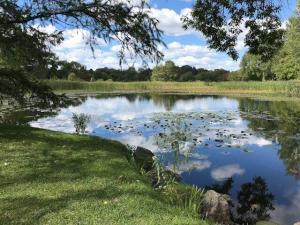Your pond has an aquatic food chain that dependent on the relationship between animals and plants. The food chain is self- sustainable with the help of sunlight and most likely will change as your pond ages or you off-set the balance by adding a product like a chemical. At the top of the food chain are the apex predators that live in the pond like gamefish and outside of the pond like fish eating critters. Gamefish, grass carp, frogs, and other relatives all fit into the category of secondary consumers. An interesting fact about secondary consumers is they do not produce their own food and are reliant on lesser animals or plants for nutrition. Think of a pond that is full of largemouth bass, this is not a vacation retreat for frogs or any smaller fish. The next level down from the top is occupied by the primary consumers and includes tadpoles, insects, clams and zooplankton. As you walk around your pond you should notice an abundance of these consumers at different times of the year. Once again, it’s important to understand that these smaller consumers cannot produce their own food and are dependent on other organisms for nutrition. The biological engine of a pond is the group of primary producers. These micro-organisms (algae and macrophytes) have the ability to make their own food through the process of photosynthesis or chemosynthesis. Primary producers are very responsive to the availability of nutrients in the water. At the bottom of the food chain are the decomposers who seldom receive the acknowledgement that they deserve. Fungi and multiple species of bacteria reduce the waste that settles to the bottom of the pond. If this maintenance crew decides not to show up for work, the ecology of your pond will shift towards an unbalanced system. Take a shovel or rake and disturb the bottom at various locations around your pond and if you notice black muck with a hint of odor it’s time to help out the decomposers with treatments of probiotic bacteria.
Considerations:
- A pond is out of balance when one or more levels of the food chain are interrupted or eliminated. Example, grass carp deplete the macrophytes and now the water is overpopulated with planktonic algae or cyanobacteria.
- Chemical additives manipulate the food chain and create an imbalance.
- Duckweed, watermeal, or other surface covering plants are an indicator of a food chain problem.
- Cyanobacteria is capable of killing or minimizing the food chain from top to bottom.
- Before you add pond dye think what happens to the primary producers when sunlight is limited.
If your pond is balanced and you are enjoying the value of having one on your property, but you still want to fiddle with the aquatic food chain I recommend turning someone else’s pond into a science experiment and see what happens.


